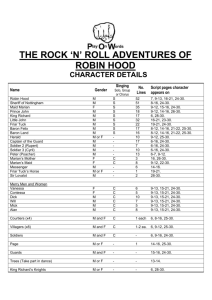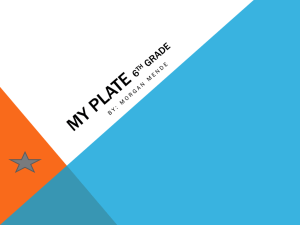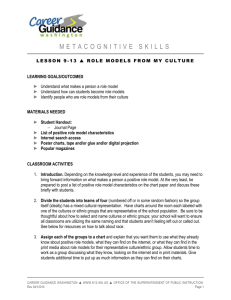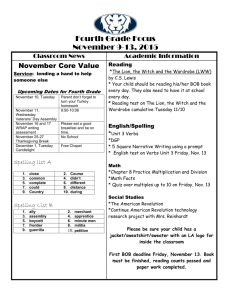Review Q and A-Chap 19-21jm
advertisement
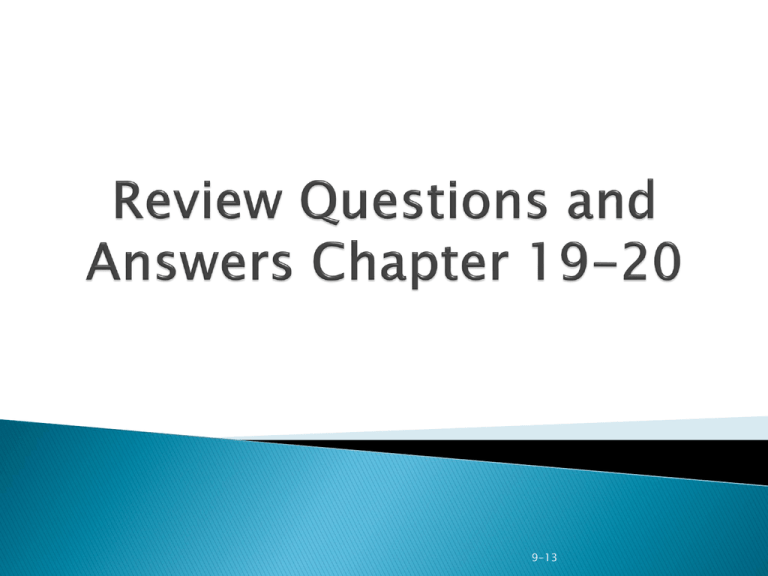
9-13 1. For what amount of time should pressure be applied for a nosebleed? ◦ ◦ ◦ ◦ A. 5 minutes B. 20 minutes C. 45 minutes D. Pressure should not be applied for a nosebleed 9-13 1. For what amount of time should pressure be applied for a nosebleed? ◦ ◦ ◦ ◦ A. 5 minutes B. 20 minutes C. 45 minutes D. Pressure should not be applied for a nosebleed 9-13 2. All of the following are useful recommendations to prevent a recurrence of epistaxis except one. Which one is the exception? ◦ A. avoiding medications with anticoagulant properties ◦ B. avoiding bending at the waist for 24 hours ◦ C. keep the head elevated for 4 hours ◦ D. using a dehumidifier in the home 9-13 2. All of the following are useful recommendations to prevent a recurrence of epistaxis except one. Which one is the exception? ◦ A. avoiding medications with anticoagulant properties ◦ B. avoiding bending at the waist for 24 hours ◦ C. keep the head elevated for 4 hours ◦ D. using a dehumidifier in the home 9-13 3. Profuse bleeding of dark, red blood out of the nose is indicative of which type of nosebleed? ◦ ◦ ◦ ◦ A. anterior B. posterior C. mucosal D. septal 9-13 3. Profuse bleeding of dark, red blood out of the nose is indicative of which type of nosebleed? ◦ ◦ ◦ ◦ A. anterior B. posterior C. mucosal D. septal 9-13 4. The most common site for epistaxis is ◦ ◦ ◦ ◦ A. the nares B. Woodruff’s plexi C. Kiesselbach’s plexus D. none of the above 9-13 4. The most common site for epistaxis is ◦ ◦ ◦ ◦ A. the nares B. Woodruff’s plexi C. Kiesselbach’s plexus D. none of the above 9-13 5. The most common cause of epistaxis is ◦ ◦ ◦ ◦ A. digital manipulation B. hypertension C. blood dyscrasia D. foreign body 9-13 5. The most common cause of epistaxis is ◦ ◦ ◦ ◦ A. digital manipulation B. hypertension C. blood dyscrasia D. foreign body 9-13 6. All of the following are systemic conditions that are often associated with epistaxis except one. Which one is the exception? ◦ ◦ ◦ ◦ A. neoplasm B. Thrombocyopenia purpura C. Anemia D. arteriosclerosis 9-13 6. All of the following are systemic conditions that are often associated with epistaxis except one. Which one is the exception? A. neoplasm B. Thrombocyopenia purpura C. Anemia D. arteriosclerosis 9-13 7. Applying ice to the nose during epistaxis is helpful as it provides ◦ ◦ ◦ ◦ A. cauterization B. angioedema C. vasoconstriction D. vasodilation 9-13 7. Applying ice to the nose during epistaxis is helpful as it provides A. cauterization B. angioedema C. vasoconstriction D. vasodilation 9-13 8. All of the following are agents that have anticoagulant properties except one. Which one is the exception? ◦ ◦ ◦ ◦ A. acetaminophen B. aspirin C. ginkgo biloba D. clopidogrel 9-13 8. All of the following are agents that have anticoagulant properties except one. Which one is the exception? A. acetaminophen B. aspirin C. ginkgo biloba D. clopidogrel 9-13 1. A low dosage of aspirin over a long period of time ◦ A. has been implicated in excessive postsurgical bleeding ◦ B. has minimal or no effect on excessive bleeding ◦ C. should be avoided entirely if surgery is to be performed ◦ D. should be minimized before surgery 9-13 1. A low dosage of aspirin over a long period of time ◦ A. has been implicated in excessive postsurgical bleeding ◦ B. has minimal or no effect on excessive bleeding ◦ C. should be avoided entirely if surgery is to be performed ◦ D. should be minimized before surgery 9-13 2. The medical consensus involving treatment of hemophiliacs before dental surgery is ◦ A. to stop all medications 48 hours before surgery ◦ B. that all dental extractions be performed in a hospital setting ◦ C. that local hemostasis and systemic treatment must be combined 9-13 2. The medical consensus involving treatment of hemophiliacs before dental surgery is ◦ A. to stop all medications 48 hours before surgery ◦ B. that all dental extractions be performed in a hospital setting ◦ C. that local hemostasis and systemic treatment must be combined 9-13 3. After a dental extraction the patient should not ◦ A. exercise for 12-24 hours ◦ B. lie down with head elevated ◦ C. be concerned if blood continues to flow heavily from the extraction site ◦ D. apply pressure to extraction site for more than 20 minutes 9-13 3. After a dental extraction the patient should not ◦ A. exercise for 12-24 hours ◦ B. lie down with head elevated ◦ C. be concerned if blood continues to flow heavily from the extraction site ◦ D. apply pressure to extraction site for more than 20 minutes 9-13 4. The second most common problem in dental surgery is ◦ ◦ ◦ ◦ A. fear and anxiety B. hemorrhage C. infection D. lack of patient compliance with postsurgical instructions 9-13 4. The second most common problem in dental surgery is ◦ ◦ ◦ ◦ A. fear and anxiety B. hemorrhage C. infection D. lack of patient compliance with postsurgical instructions 9-13 5. A hematoma is ◦ A. an unavoidable side effect of dental extraction ◦ B. often caused by an incorrect choice of local anesthetic ◦ C. a collection of bacteria trapped beneath the skin ◦ D. most often caused by trauma 9-13 5. A hematoma is ◦ A. an unavoidable side effect of dental extraction ◦ B. often caused by an incorrect choice of local anesthetic ◦ C. a collection of bacteria trapped beneath the skin ◦ D. most often caused by trauma 9-13 6. Which of the following anticoagulation medications is most likely to be discontinued prior to dental surgery? ◦ ◦ ◦ ◦ A. B. C. D. Aspirin Heparin Plavix Pradaxa 9-13 6. Which of the following anticoagulation medications is most likely to be discontinued prior to dental surgery? A. Aspirin B. Heparin C. Plavix D. Pradaxa 9-13 1. Which of the following intraocular foreign bodies will be more likely to cause an infection? ◦ ◦ ◦ ◦ A. glass B. calculus C. instrument tip D. study model stone 9-13 1. Which of the following intraocular foreign bodies will be more likely to cause an infection? ◦ ◦ ◦ ◦ A. glass B. calculus C. instrument tip D. study model stone 9-13 2. All of the following are symptoms of a foreign body in the eye except one. Which one is the exception? ◦ ◦ ◦ ◦ A. burning in the eye B. tear production C. double vision D. epistaxis 9-13 2. All of the following are symptoms of a foreign body in the eye except one. Which one is the exception? ◦ ◦ ◦ ◦ A. burning in the eye B. tear production C. double vision D. epistaxis 9-13 3. The cotton-tipped applicator method of intraocular foreign body removal is best used for removal of which type of foreign body? ◦ ◦ ◦ ◦ A. embedded B. superficial C. chemical D. none of the above 9-13 3. The cotton-tipped applicator method of intraocular foreign body removal is best used for removal of which type of foreign body? ◦ ◦ ◦ ◦ A. embedded B. superficial C. chemical D. none of the above 9-13 4. When using the irrigation method of intraocular foreign body removal, the solution should be ◦ A. applied directly onto the cornea ◦ B. applied from the lateral portion of the eye to the medial portion of the eye ◦ C. applied from the medial portion of the eye to the lateral portion of the eye ◦ D. heated before application 9-13 4. When using the irrigation method of intraocular foreign body removal, the solution should be ◦ A. applied directly onto the cornea ◦ B. applied from the lateral portion of the eye to the medial portion of the eye ◦ C. applied from the medial portion of the eye to the lateral portion of the eye ◦ D. heated before application 9-13 5. Which method of intraocular foreign body removal is best to use for a chemical splash? ◦ A. cotton-tipped applicator ◦ B. irrigation method ◦ C. rub the eye vigorously until the object is removed. 9-13 5. Which method of intraocular foreign body removal is best to use for a chemical splash? A. cotton-tipped applicator B. irrigation method C. rub the eye vigorously until the object is removed. 9-13 6. The nonvascular transparent coat that covers the colored iris is the ◦ ◦ ◦ ◦ A. cornea B. globe C. sclera D. pupil 9-13 6. The nonvascular transparent coat that covers the colored iris is the A. cornea B. globe C. sclera D. pupil 9-13
